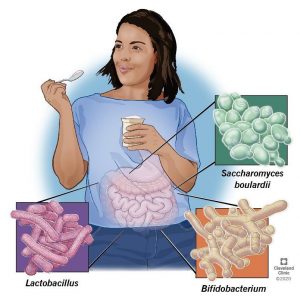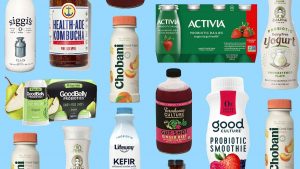Probiotics | Overview
- Probiotics are biological agents, usually eaten up as food supplements, that can favourably impact the microbial ecology of the host.
- Probiotic bacteria have become increasingly common during the last two decades as an outcome of the continuously broadening scientific indication edging to their helpful impacts on human health.
Microbial Species with Applications as Probiotics
- As far as nourishment is involved only the strains categorized as lactic acid bacteria are of important and among them, the ones with the most crucial properties in an applied context are those belonging to the genera Lactobacillus and Bifidobacterium.

- Lactic acid bacteria are Gram-positive, catalase-negative bacterial are able to generate lactic acid as the main end-product of carbohydrate fermentation. The genus Bifidobacterium is therefore rather traditionally than phylogenetically recorded among them as they use several metabolic pathways.
- Two other species playing a crucial role in the food industry, especially dairy products, although not actually considered as probiotics are Streptococcus Thermophiles and Lactococcus lactis, two of the most commercially significant lactic acid.
What makes a probiotic?
- Probiotics should be specified at the genus, species and strain level, utilizing accurate molecular and physiological procedures.
- The strain should be inserted in an internationally recognized culture collection so that scientists are able to replicate disseminated research on the strain and to serve as a reference strain.
- Reasonable in vitro and animal assessments must be performed to better understand the physiological attributes of the strain.
- Appropriately controlled studies that document a health benefit in the target host must be conducted.
- An effective dose of the viable probiotic must be present in the final product through the end of shelf life.
Mechanism of probiotics activity
- Major probiotics mechanism of action contain enhancement of the epithelial barrier, increased bonding to the intestinal mucosa, and concomitant inhibition of pathogen, active exclusion of pathogenic microorganism production of anti microorganism substances and modulation of the immune system.
- Enhancement of epithelial boundary
- Gained adhesion to the intestinal mucosa
- Active exclusion of pathogenic microorganisms
- The output of antimicrobial substances
Probiotics and Food Products
- The range of food products including probiotic strains is large and still prospering.
- The main products occurring in the market are dairy-based ones including fermented milk, cheese, ice cream, buttermilk, milk powder, and yoghurts.
- Non-dairy food applications contain soy-based products, nutrition bars, cereals, and a variety of juices as applicable means of probiotic delivery to the buyer that must be dealt with in analyzing the usefulness of the incorporation of the probiotic strains into such products are, besides safety, the compatibility of the product with the microorganism and the supervision of its viability through food processing, packaging, and storage conditions.
- The product’s pH for a sample is a significant factor specifying the incorporated probiotic’s survival and growth, and this is one of the intentions why soft cheeses seem to have a number of benefits over yoghurt as delivery systems for viable probiotics to the gastrointestinal tract.
- Current technological inventions provide directions to overcome probiotic vitality and viability issues offering new alternatives for their incorporation in new media and subsequent achievement of improving buyer demand.
- Microencapsulation technologies have been expanded to ensure the bacteria from the destruction caused by the external atmosphere.
- In the same time, the capacity of lantibiotics’—substances with antimicrobial properties—production by bifidobacterium is being analyzed in order to be applied in the food area.

Health Benefits of probiotics
Exploration has been promising for these friendly critters. Potential advantages of probiotics have been seen in the therapy or prevention of:-
- diarrhoea
- irritable bowel syndrome
- ulcerative colitis
- Crohn’s disease
- pylori (the cause of ulcers)
- vaginal infections
- urinary tract infections
- recurrence of bladder cancer
- infection of the digestive tract caused by Clostridium difficle
- pouchitis (a possible side effect of surgery that removes the colon)
- eczema in children
REFERENCES
- https://www.nccih.nih.gov/health/probiotics-what-you-need-to-know
- https://my.clevelandclinic.org/health/articles/14598-probiotics